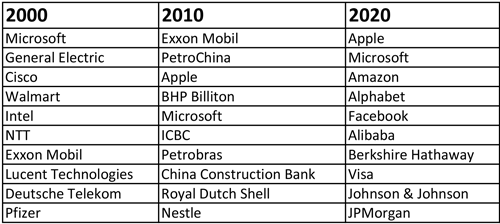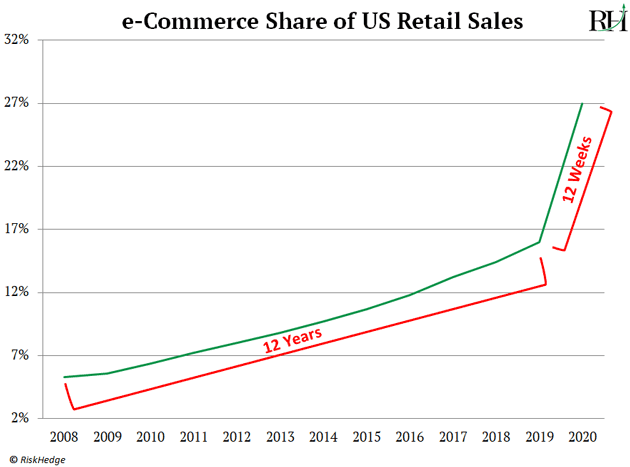
The next great trillion-dollar stock
- Stephen McBride
- |
- July 6, 2020
- |
- Comments
This article appears courtesy of RiskHedge.
I’m about to show you the most important table in all of investing.
Please look at it closely.
Below, you’ll find the world’s 10 largest publicly traded companies in 2000... 2010... and 2020.

You probably recognize most of these stocks. The 2020 column reads like a “who’s who” of the most popular US stocks today.
- But you’ll notice a strange pattern when you look across all three columns.
The list completely changes every decade.
In other words, most of the world’s dominant companies falter and fall out of the top 10. Only Microsoft has maintained its position since 2000.
And usually when a stock drops off the list, it does not decline gracefully. Investors who owned it get crushed.
For example, from 2001–2018… General Electric (GE) stock plunged 79%... Cisco (CSCO) collapsed 89%... and Intel (INTC) dropped 56%.
Now I’ve practically memorized all the “top 10” lists going back to the ‘60s...
And what they indicate might shock you: Owning the largest companies in the world is usually a money-losing strategy.
- Instead, you want to own the “rising stars.”
In other words, you generally don’t want to own the stocks “at the top of the mountain” today. Instead, hunt for the stocks that are climbing the mountain. The ones that will be on top in 5–10 years.
In my experience, most investors do the opposite. They gravitate toward companies that are already huge. They think huge = safe. They assume today’s powerful companies like Apple and Facebook will be powerful forever.
That’s not usually how it turns out. We see it play out over and over again in the stock market: Smaller, hungrier companies rise up and eat the lunch of larger, older companies.
Today, I’ll predict one new rising star that could someday claim a spot in the top 10.
- Have you heard of Shopify (SHOP)?
As I explained recently, Shopify builds online stores for mom-and-pop shops.
From creating the website… to shipping orders… to processing payments… Shopify is a “one-stop shop” for anyone wanting to sell online.
Americans are spending more money online than ever before. In 2009, internet shopping was a $100 billion business. Last year consumers spent over $600 billion online.
The thing is… mom-and-pop shops only grab a tiny slice of the pie.
There are 30 million small businesses in the US. They make up 99.9% of all companies in America. And according to IRS data, firms with less than $100,000 in annual sales raked in a combined $2.2 trillion last year.
Yet almost none of this happens online.
A recent CNBC poll found almost half of small businesses don’t even have a website.
And according to Gallup, 2/3 of mom-and-pop stores that sell online generate less than 10% of their sales on the internet.
- The coronavirus sparked a wave of mom-and-pop stores to shift online.
It forced tens of millions of businesses to close their doors for months. And the only way to keep cash coming in was to sell online. Businesses that didn’t even have a rudimentary website were suddenly rushing to set up fully functional internet stores.
Web hosting company GoDaddy found 20% of small businesses sold an item online for the first time ever during lockdown.
Until recently, creating an online store during a pandemic would have been impossible. But as I showed you, Shopify came to the rescue for millions of mom-and-pop shops.
New stores created on Shopify’s platform surged 62% during the lockdowns. And the most shocking stat of all: Stores with a presence on Shopify recouped 94% of lost in-person sales with online orders!
Internet shopping has grown more in the past 12 weeks than it did during the last decade, as you can see here:

- The hundreds of thousands of small businesses that shifted online are never going back.
For as little as $29 a month, Shopify manages every part of their online stores, including deliveries.
To put it mildly, that’s a real bargain... considering Shopify was the only thing that saved many mom-and-pops from going belly up during lockdowns.
In fact, being online also helps them reach thousands of new customers. Internet shopping has no boundaries. With a Shopify website, the neighborhood craft store can now sell to folks across the country.
- Shopify is seizing an $80 billion pot of gold.
Remember, Shopify is like an invisible partner that allows businesses to build their own online brands.
It handles the “dirty work” of online selling… like payments, shipping, and marketing… without taking any of the credit. In fact, last year almost 300 million people bought something on Shopify without even knowing it existed.
This is why it’s fast becoming the “go-to” solution for anyone wanting to sell anything online.
Shopify now powers over one million merchants from 175 countries. And these businesses sold $60 billion worth of goods through its platform last year.
- Yet… this is only the tip of the iceberg.
Shopify estimates there are 47 million small businesses that it doesn’t serve yet. It collects $1,650/year from each merchant, on average. That means Shopify could potentially rake in $80 billion/year.
Sales hit $1.5 billion last year. Shopify’s revenues could soar 10X and it would still have captured just 20% of its target market.
And that’s not even counting the larger brands Shopify is serving.
It already hosts websites for giants like Unilever… Red Bull… Heinz… Budweiser… Pepsi… and Nestle. And these big firms typically pay $2,000 per month for Shopify’s premium offering, Shopify Plus.
- Shopify’s stock has been on a tear over the past two years, handing investors 745% gains:

That’s a big gain in a short period, so I wouldn’t go “all in” on the stock here.
But remember this: Online business is still only in its first inning.
Shopify is the key to unlocking business on the internet for millions of mom-and-pops.
It’s one of the most important internet companies investors aren’t paying attention to.
And I expect by 2030, we might be talking about Shopify like we talk about Amazon and Apple today.
Stephen McBride
Editor — Disruption Investor
Stephen McBride is editor of the popular investment advisory Disruption Investor. Stephen and his team hunt for disruptive stocks that are changing the world and making investors wealthy in the process. Go here to discover Stephen’s top “disruptor” stock pick and to try a risk-free subscription.
|

This article appears courtesy of RH Research LLC. RiskHedge publishes investment research and is independent of Mauldin Economics. Mauldin Economics may earn an affiliate commission from purchases you make at RiskHedge.com
